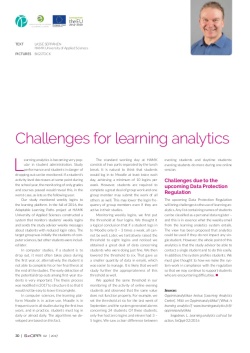Article first published on SeOppi 2/2017.
Text: Lasse Seppänen, Häme University of Applied Sciences (HAMK)
 Learning analytics is becoming very popular in student administration. Study performance and students in danger of dropping out can be monitored. If a student’s activity level decreases at some point during the school year, the monitoring of only grades and courses passed would reveal this, in the worst case, as late as the following year.
Learning analytics is becoming very popular in student administration. Study performance and students in danger of dropping out can be monitored. If a student’s activity level decreases at some point during the school year, the monitoring of only grades and courses passed would reveal this, in the worst case, as late as the following year.
Our study monitored weekly logins to the learning platform. In the fall of 2016, the Adaptable Learning Paths project at HAMK University of Applied Sciences constructed a system that monitors students’ weekly logins and sends the study advisor weekly messages about students with reduced login rates. The target group was initially the students of computer sciences, but other students were included later.
In computer studies, if a student is to drop out, it most often takes place during the first year, or, alternatively, the student is not able to complete his or her final thesis at the end of the studies. The early detection of the potential drop-outs among first-year students is very important. The thesis process was modified in 2017 to structure it so that it would not be easy to leave it incomplete.
In computer sciences, the learning platform Moodle is in active use. Moodle is in frequent use in all studies during the first two years, and in practice, students must log in daily or almost daily. The algorithms we developed are based on this fact.
The standard working day at HAMK consists of two parts separated by the lunch break. It is natural to think that students would log in to Moodle at least twice each day, achieving a minimum of 10 logins per week. However, students are required to complete a great deal of group work and one group member may submit the work of all others as well. This may lower the login frequency of group members even if they are active in their studies.
Monitoring weekly logins, we first put the threshold at four logins. We thought it a logical conclusion that if a student logs in to Moodle only 0 – 3 times a week, all cannot be well. Later, we tentatively raised the threshold to eight logins and noticed we obtained a great deal of data concerning students who were doing just fine. We then lowered the threshold to six. That gave us a smaller quantity of data in emails, which was easier to manage. It is likely that we will study further the appropriateness of this threshold as well.
We applied the same threshold in our monitoring of the activity of online evening students and observed that the same value does not function properly. For example, we set the threshold at six for the last week of September, and the system generated alarms concerning 24 students. Of these students, only five had zero logins and eleven had 3 – 5 logins. We saw a clear difference between evening students and daytime students: evening students do more during one online session.
Challenges due to the upcoming Data Protection Regulation
The upcoming Data Protection Regulation will bring challenges to the use of learning analytics. Any list containing names of students can be classified as a personal data register – and this is in essence what the weekly email from the learning analytics system entails. The view has been proposed that analytics could be used if they do not impact any single student. However, the whole point of this analytics is that the study advisor be able to contact a single student and to do this easily. In addition, the system profiles students. We must give thought to how we make the system work in compliance with the regulation so that we may continue to support students who are encountering difficulties.
Sources
Oppimisanalytiikan keskus [Learning Analytics Centre]. Mitä on Oppimisanalytiikka? [What is learning analytics?] www.learninganalytics.fi/fi/oppimisanalytiikka
Seppänen, L. Learning analytics call out for action, SeOppi 02/2016
